It’s such an odd thing we do with dogs. We’ve spent millenia domesticating this creature that, at the time we began the whole project, would have had no qualms about gobbling up our kids.
But we didn’t just tame them. As we’ve done with with all domesticated animals, we bred into them the traits most beneficial to us. We changed them. At first, we retained their more primal instincts, to protect our families, our livestock, and our reserves of food. We bred them strong and loud, rippling with ferocity and thew.
But then we decided we wanted dogs as companions, so we brought them into our homes. And we changed them again. I have a theory that in the modern dog, we’ve captured what we love most about those most treasured years of parenthood, that magical time when a kid is between about three and about six, when they’re just independent enough to seem like little humans, but still look up at you with undiluted love and wonder, still think you’re hilarious, still consider you the coolest thing around.
We’ve created not just a companion, but a being that’s eager to please us. And in the process, we made one with an uncanny ability to read us. We gave them supple, tactile coats that we find soothing, and those wide, dilated eyes that signal unconditional love. They know when we’re sick, when we’re sad, when we’re anxious. They’re fuzzy little oxytocin dispensers.
The paradoxical part of this whole endeavor is that as we’ve created these little love machines, we then bring them into our lives knowing full-well that they’ll precede us in death — that one day they’ll leave us devastated. That isn’t part of the bargain with kids.
And yet they’re more than worth it. I’ve now lost five dogs in my life that I knew well. And I’ll keep adopting them.
If you haven’t guessed by now, this is one of those Tribute to My Dead Dog posts. I know, I know. It’s tired. It’s cliche. But hey, what’s the point of having your own newsletter if you can’t wax self-indulgently now and then? So Daisy, this is for you.
Dogs live long enough to bridge a a couple phases in our lives. When I adopted Daisy, I was going through a personal and professional transition. I had lived in Washington, D.C. for about 10 years, and was more than ready to leave. I had just gotten out of a five-year relationship, and lost a dog in the breakup. That left Harper, the dog I’d had for nine years, without a companion.
Two companions, actually, because Harper also adored my ex-girlfriend. Harper had creaky back knees, so she was no friend of stairs. When my ex moved out, she’d left some clothes in a bag in the basement. I’d come home to find that Harper had used those wobbly knees to traverse the steep stairwell to curl up with the last thing in the house that still smelled like my ex.
Dogs, man.
I adopted Daisy in 2009 outside of a Wegmans, where a local shelter had set up a table there with some puppies. If you know me at all, adopting a dog outside of a Wegmans makes perfect sense. They’re two of my favorite things in this life.
The thing is, when I saw the adoption booth, I had really just planned to look. Daisy had other plans. I brought her home a week later.
Harper had been slowing down for the previous year or so. I assumed it was because of her legs. I didn’t know it at the time, but it was actually because of the tumor growing in her snout. But she perked up when I brought Daisy home. Daisy gave her a reason to go outside. To play. To frolic.
I’m sure Daisy also annoyed the hell out of her. She pestered Harper, nibbled at her food, interrupted her naps, insisted on sharing her bed, and I swear at times seemed to deliberately nip at the old pup’s most vulnerable spots — her back knees and her nose. But Harper embraced the new puppy, protected her, showed her the ropes. I think Daisy brought some joy, revelry, and spontaneity in what would be Harper’s final days.
Those last days began to fade in December of 2012. I had planned to drive from D.C. to my parents’ place in Indiana for the holidays. Harper had been wheezing a lot in recent weeks, and I’d just assumed she had a virus of some kind. But on the morning I was planning to leave, she woke me up early with a fit of coughing and sneezing.
Then I saw it — the wheezes included droplets of blood. I took her to the vet, where an X-ray revealed the tumor. The vet said there was little they could do to treat it. They could put her on steroids, which would temporarily shrink the tumor, give her some relief, and let me take her back to Indiana. But the humane course would be to put her down within a few weeks. I drove home the next day.
If you’ve ever taken I-70 along the Pennsylvania Turnpike, you’re probably aware of the surreal town of Breezewood. The entire place exists to service the interstate and its passengers. Its principal “residents” are fast food joints, cheap buffets, and sketchy motels. Business Week once called it “a blaze of neon in the middle of nowhere, a polyp on the nation's interstate highway system.”
So along the Pennsylvania Turnpike, on the eve of Christmas Eve, just as it began to snow . . . my car broke down just short of the off-ramp to Breezewood. I was still a good seven hours from home. The sun had begun to set, and it was about 25 degrees.
I rounded up the dogs, gathered my bags, and called AAA, which sent a cab to pick us up and take us into town. I went through three hotels before I finally persuaded the manager of of the fourth give me a room, despite a clearly posted “No Pets” policy. It was incredibly kind of him. He asked only I give him a good rating on Trip Advisor in return. The room was dirty, smelled of smoke, and had paper-thin walls. It looked like the sort of place you’d go for a cheap affair. Or the set of the murder scene that opens a film noir flick. But I gave it five stars.
A couple days before all of this, I had been quoted in a front-page article in the New York Times. I was feeling pretty full of myself. Now, I was staring down my first holiday season alone in several years, in a forty-bucks-a-night motel in a godforsaken interstate town, unable to sleep over the sounds of an old dog coughing up blood and the nervous pacing of a confused and excitable puppy — all as my car collected snow on the side of the interstate.
I had by then built a decent readership audience with my blog and I posted about my predicament. One of my readers happened to own a car dealership. He generously provided me with a loaner car to get back to Indiana. The dogs and I hit the road the following day.
I tend to remember important life events by the drives that preceded those events. I still remember the morning drive to my high school graduation — more than I remember the graduation itself. I even remember the song I played. (If you must know, it was“Rise and Shine” by Extreme. Don’t judge.) I remember my drive to D.C. to find work after I graduated college, and the drive my wife and I made to New York for our wedding.
That drive from Breezewood to my parents’ place is also one that sticks in my head. Even at the time, I knew it was the start of something new, that it was a drive I’d remember. It had cleared up, and a blinding sun bounced around the snow as we cut a path through the Allegheny Mountains.
At some point in Western Ohio it all caught up to me. I remember looking in my review mirror into the backseat and seeing Daisy nervously licking Harper’s coat, trying to give the old dog comfort as she struggled to breathe. That’s when I just broke down. I sobbed for a good half hour. After about 10 minutes, Daisy apparently thought I needed more comfort than Harper, so she hopped over the console and curled up in the passenger seat next to me. By the time I got to Indiana I decided I needed to leave D.C. — to start fresh someplace else.
I put Harper down after the holidays. Daisy stayed with some neighbors. The hardest part of the whole thing was probably watching the poor little puppy hunt around for her pal and mentor for the week. A blizzard then hit — the second that year in the D.C. area. Daisy had frolicked with Harper through the first one. Now it was just the two of us. So we bonded for a couple snowbound afternoons.
I wasn’t really in a position to get another dog at the time, so Daisy coped by attaching herself to my hip. I was fine with that. I needed it too. But she’d also become fiercely protective of me, which would later have some unfortunate consequences.
I had decided to leave D.C., but I still had to figure out where to move. I had been to Seattle several times and really loved that town. But I’d also been working on a book proposal about the reporting I’d been doing in Mississippi. If the book deal went well, Seattle wouldn’t be practical (I did eventually co-write that book, but only after writing a different book first). I had a couple friends who’d lived in Nashville for a time and had raved about the city. Great music, great food, and access to Mississippi. That was enough for me.
So in May of 2010, Daisy and I packed up and headed to Music City. It would be the freshest of fresh starts. I only knew a couple people in Nashville at the time. But I was armed with an adorable puppy.
We settled into an apartment on Music Row, in a building that featured a guitar-shaped swimming pool designed by Webb Pierce. Yes, we went full Nashville.
Daisy and I then went about exploring our new hometown. We hit the dog parks, trails, and any restaurant we could find with a dog-friendly patio. Daisy pooped on the lawns of every major record label. A friend and I started a little venture called “Songs From My Couch,” in which we recorded musicians playing in my apartment. I mean, Matthew Perryman Jones is terrific here in this beautiful take on Paul Simon. But Daisy is really the star.
The pup quickly made friends. One tenant in my building had a young staffie mix named Leo. The two hit it off like no two dogs I’ve ever seen (the irony of his name, which is also shorthand for “Law Enforcement Officer,” didn’t escape me. I chalked it up to teenage rebellion). Leo’s owner walked him on a fairly regular schedule. Their route included the sidewalk outside my building, which you could see from the window in my apartment. The two dogs had such a bond that when it was time for Leo’s afternoon walk, Daisy go to the window and wait for Leo’s walk. When she spotted him, she’d call out to him, then bug me until I took her out to see him. It became such a regular event that I captured it one afternoon with my camera.
Leo had some medical problems, and eventually needed a procedure that left him unable to direct the flow of his urine. He was already a bit clumsy and reckless. Now he was walking lawn sprinkler, putting anyone within a three foot diameter at risk. Daisy found this delightful.
Leo and his owner eventually moved away, and Daisy never really bonded with another dog like that again. We tend to project uniquely human traits onto our dogs, and it’s entirely possible that I’m doing that here. But I swear it’s like he was her “one that got away.”
I won’t argue that Daisy was the smartest dog in the world. She got by on her charm, and was more brawn than brains. But she did have a few flashes of brilliance. Once, when she was a puppy, I tried to treat her to some fancy wet food. Big mistake. My small apartment became her personal vomitorium. Somehow, she seemed to have thrown up several times the amount of food I’d given her. I didn’t want to leave her alone while she was sick, but a lot of dog vomit in a small apartment is . . . pungent. I tried a vanilla-scented candle, which only made the place smell like vanilla-scented vomit.
After each of the first few incidents, she watched as I went to the bathroom, got an old towel, and cleaned up the mess. I wasn’t mad at her, of course. But she could tell that as she kept throwing up, I got increasingly frustrated. I also happened to be on deadline, so eventually I decided to just work by an open window and clean it all up once at once she’d gotten it out of her system. Seeing that I was no longer cleaning up the mess, Daisy went to the bathroom, grabbed a towel in her mouth, and put it on the pile of fresh vomit — just as I had been doing. I mean, sure, after doing that she then laid down on the towel. And then she rolled around. But still.
I had started writing quite a bit about the use of drug dogs back then. In my reading, I’d learned some fascinating stuff about the psychology of dogs. For example, it’s true that dogs have an incredible sense of smell, finely tuned by millions of years of evolution. But we’ve also bred into domesticated dogs an overriding desire to please us. And in doing so, we also created a corresponding ability to read us. This has been born out in well-designed tests of K9-handler teams, which have shown that drug dogs are far more likely to falsely alert to packages designed to trick their handlers (a package with some white powder leaking out, for example) than those designed to trick the dogs themselves (a package stuffed with sausages).
If these traits aren’t factored into a drug dog’s training, you aren’t training a drug-sniffing machine, you’re training a machine that just confirms its handler’s hunches. Invasive searches based on hunches are precisely what the Fourth Amendment is supposed prevent. It’s a problem the Supreme Court still seems unable to grasp.
But learning all of this gave me a new appreciation and understanding of my own dogs. I’d always been amazed at what great judges of character both Daisy and Harper had been. When my cranky, absentee D.C. landlord came around, they’d both snarl and bark at him. But when I had friends or a date over — even someone the dogs had never met — they were warm and affectionate. I had clearly chosen genius dogs.
But of course that isn’t what was happening at all. The dogs were reading me. I didn’t like my landlord, so they didn’t like him either. I warmly greeted my friends, so they did, too.
One evening in the spring of 2013, I received an unexpected text message. The previous year, I’d been flirtatiously emailing with a woman in New York, a fellow journalist. We’d hung out a few times when I visited, and we’d hit it off. But it didn’t work out at the time, and we had stopped communicating. The text was from her. She was in town for a conference. She asked, could we catch up? I invited her over.
My plan was to play it cool. I wasn’t going to let on that I’d been thinking about her for the last several months. I’d keep her guessing. I might try my hand at aloof.
Daisy had other plans. Pretty much the moment the woman walked through the door, Daisy nuzzled up to her. Jumped on her lap. Licked her. This was the first time they’d met. There was no fooling my dog. Daisy knew I was into this woman. So she loved her too.
Liliana moved to Nashville in 2015. We got married the following year.
Liliana also had a dog, a shy, angsty, handsome Sheltie/collie mix named Wally. (His photo now adorns this site.) The first time she brought Wally to Nashville, we introduced the two dogs. Daisy wasn’t quite as welcoming of Wally as she’d been of Liliana. We first introduced them outside, and it seemed to go well. But within a few minutes of bringing Wally into my apartment, Daisy lunged at him, and put a gash just above his eye. I was mortified.
But that, too, would work to my advantage. I swiftly pulled Daisy off of Wally, scolded her, and applied some Neosporin to Wally’s wound. Liliana told me later that this earned me some huge points.
Daisy went at Wally one more time, shortly after we all moved into our new home. I had just come in the door, and there was some jostling over who would greet me first. They scuffled, and Daisy put a hole in Wally’s ear.
The scuffles stopped after that, but Daisy did continue to bully Wally. She liked to bite at the air near his ear. Not on his ear. Just near it. Just as a little reminder. Wally is reserved and empathetic. Daisy was brash and a little boorish. When we were out on walks, as Wally would begin to pee on a spot, Daisy would nudge him out of the way and flood his pee with hers. It’s like Wally was the canine equivalent of a thoughtful, talented graffiti artist, and Daisy the vandal who tagged “DAZY WUZ HERE” over his masterpieces.
Wally did get back at her sometimes, though. And when he did, he went big. When Liliana was out of town, Wally often wouldn’t poop until she returned. Not an uncommon thing for a dog. After one trip, I went to pick her up from the airport. Wally apparently could hold it in no more. We came home to a massive pile of poop. And of all the rooms, all the corners, all the spots around the house he could have chosen, he unloaded it all right in front of Daisy’s food bowl.
Daisy came trotting down the stairs, looked at the aftermath, and just looked at us with an expression that said, “What the fuck is this?”
He did it again a few months later.
Wally had one other trick he pulled on Daisy that still amazes me today. You can see the sidewalk in front of our home from our second floor. So both dogs often sat on a perch where they could see out the window, then furiously barked and ran to the door whenever someone passed by. Daisy being Daisy, she always had to get to the door first, even if she had to side-check Wally out of the way as she did.
Both dogs competed to sit on the couch I used while working or watching TV. Since they didn’t really cuddle with one another, once one dog had the couch spot, the other had to settle for a less coveted spot on the floor. One time, while Daisy was on the couch and Wally on the floor, I noticed Wally raise his head, begin furiously barking, and slightly move toward the door. Daisy, always having to outdo Wally, started barking louder, steamrolled by Wally, and flew down the stairs to the door. Wally then stopped barking, turned around, and calmly took her spot on the couch.
It was just a genius bit of jujitsu. I first thought there’s no way a dog could be that cunning, and dismissed it as coincidence. But then he started doing it regularly.
The two eventually settled into a groove that could be best described as unhappily married middle-aged couple. It would’ve been impractical to split up — or in their case, impossible — so they just kinda’ coexisted. We have dozens of photos like these — Daisy in the foreground, Wally pensively staring into the middle distance.
The one exception to this dynamic was when we went on long car rides. For whatever reason, those would make Daisy uncharacteristically amorous. She’d start licking Wally. He had no idea what to do with this. He just looked at us utterly bewildered, like, “WHAT IS HAPPENING?”
Despite their groove, there was also always some sort of unspoken drama unfolding between them. Daisy would often watch Wally eat — like really stare him down. It seemed to really annoy him, which she seemed to enjoy. Wally isn’t really into chew toys, but Daisy was. Sometimes, we’d find a cache of chew toys piled by Wally’s bed. He still didn’t play with them. He seemed to hoarding them. Just to mess with her.
Daisy could be very funny. A favorite activity when she was bored was to toss a stuffed toy in front of herself, look at it like it had just offended her, then pounce as if it were fleeing like the pitiful coward it was. She’d furiously shake one her beloved stuffed ducks like it owed her money, looking pretty badass in the process. Then, about 20 minutes later, she’d startle herself with one of her own farts and scurry out of the room.
As all dogs do, Daisy grew older. Grayer. Lumpier. She also grew surly. She’d bark and lunge at other dogs on walks. She never attacked them, and I don’t think the other dogs themselves felt threatened. But she was definitely sending a message, and the other dogs’ owners sometimes saw it as aggressive, which could be embarrassing.
The weird thing is that she apparently didn’t do this when other people walked her. We’d also learn from the trusty lady who watches our dogs when we’re away that at her house, Daisy and Wally were pals. They’d sometimes even cuddle. This was an absolute revelation to us. (Apparently, they were also quite affectionate with our dog-watcher’s cats. But we don’t talk about that.)
A trainer later told me that Daisy’s behavior — toward Wally when I was around and toward other dogs when she was on leash — likely stemmed from her bonding to me so strongly so early in life. When Harper died, she took Harper’s place as my protector. And I apparently always needed protecting. That’s really sweet. And also a little insulting.
That sense of duty took a bad turn in the summer of 2020. We were walking the pups just outside our house when Daisy spotted another dog across the street. I had her on a retractable leash (don’t use a retractable leash!) and she made a quick lunge that caught me off-guard. She darted into the street just as an SUV was approaching.
I’ve never heard a wail quite like that. Just excruciating. We rushed her to an emergency vet. Her back leg was shattered, but she otherwise seemed okay. No other internal injuries. She’d been struck by a small corner of the truck’s front bumper, so her leg took almost all of the impact. She got lucky.
The poor driver felt terrible, and offered to split the veterinary bills with us. I thanked him and told him that wasn’t necessary. It wasn’t his fault.
Daisy eventually lost that leg. I worried that it could be a devastating blow for such an active dog with such a fierce personality. But Daisy had other plans.
She’d barely recovered before she was demanding walks again. Until the last few months of her life, she insisted on going down the steps on her own. Our backyard has a steep downward incline away from the house. Every night when I’d let her out before bed, she’d sniff and meander her way to the bottom, then determinedly race to the garage as fast as she could. She’d be out of breath by the end, but she just wanted to show she could do it.
We often joked that she probably hadn’t even noticed — that the first time after the amputation she passed in front of the mirror, she probably caught her reflection and thought, “Wait a minute. WHERE THE HELL IS MY LEG?”
Most importantly, Daisy learned absolutely nothing from the experience. She still lunged at other dogs on our walks. She still lunged at other dogs from across the street. She still lunged at other dogs, from across the street, at the precise spot where she was struck by the SUV. She’d lost one leg for me. And goddammit, she’d do it again.
For all her muscle and attitude, Daisy could also be sensitive. When I was down with a kidney stone earlier this year — probably the most painful thing I’ve ever experienced — she was clearly distressed by my distress. She’d grown less cuddly as she got older, but for that week, she insisted on laying right beside me. At one point she tried to hop up on the bed to be with me, forgetting that with just one back leg, she didn’t have the spring she once did. She went tumbling to the floor. She got up and tried again. I finally lifted her onto the bed.
Before we get to the sad part, here a few more of my favorite photos from over the years:
Late last month, we heard a thud in the bedroom. It was a big, beefy sound, like a mini-fridge had rolled off the bed. I rushed in, and saw Daisy laying on her side. She was scared. She let out a mournful wail — another devastating sound you just never want to hear come out of your dog.
But she was back on her feet after a few minutes, so I assumed she had just slipped and fallen awkwardly. Maybe she pulled a muscle.
She fell again a couple days later, and then again the morning after that. That last time, she didn’t bounce back.
There’s a fine line between brave and stupid, and Daisy didn’t pay much attention to it. Once, on a walk in the Shelby Bottoms Greenway here in Nashville, I mistakenly let her off leash. We saw a deer off in the distance. Daisy darted off as if she were going to bring it home for dinner, and disappeared around the corner. A few seconds later she reappeared. She walked back to us slowly and sheepishly, tail between her legs. That deer was a little bigger than she thought.
The hardest thing about that last time she fell is that this stupidly brave dog looked utterly scared. She didn’t know what was going on. That was new. And it was hard to see.
The vet told us she had a significant buildup of fluid around her heart, which was restricting her blood flow and making it difficult for her to breathe. She had been falling down due to a lack of oxygen.
The vet drained the membrane around her heart, and found that it was mostly blood. That suggested a mass. And that isn’t something that can be treated. She was 14 years old.
We decided to put her down that day. It was a heartbreaking decision, but after seeing the confusion, discomfort, and fear on her face that morning, it wasn’t a difficult one.
I think part of the pain and reflection we go through upon losing a dog is that their lifespans cover a significant chunk of our lives, but one that’s still short enough for us to contemplate. A dog’s death prompts us to reflect on the time that elapsed since they came into our lives, to consider how things have changed in that time, and perhaps mourn a little for the decade or so we’ve lost. When I adopted Daisy I was still in the first half of my life, and still in the first half of my career. I’m probably in the second half of both, now. When I took her in I was a little sad, a little lonely, and uncertain about where my life was headed. She was a fount of joy and comfort as I figured those things out.
My life now is happy, content, and whatever the opposite of lonely is. If you’re lucky, your dog doesn’t just become a part of your identity — of how you see yourself — the pup plays has a part in who you become. I was lucky. My life would probably have taken a very different route without her.
Daisy was a force. She entered a room with a “WHAT IS THE MEANING OF THIS?” demeanor — like you’d been been talking about her, or were making plans that didn’t include her. My wife would say she announced herself with the subtlety of the Kool-Aid Man.
As she got older she didn’t bark as much, but the house is still so much quieter without that presence. Wally clearly misses her, too. Maybe not in the way other dogs would miss a close canine friend, but I think he misses her company. She stimulated him. She kept him on his toes. He needed that.
When my wife’s sister had a baby last October, we rented an AirBnB in Brooklyn for a few weeks to help out. One of those glorious autumn New York mornings, I was walking Daisy when she caught the eye of a rugged-looking guy. You could have pulled him off the set of a bad 1980s TV show set in pre-gentrified Brooklyn. The guy kept looking at her, and then at me, as she tri-pawed her way through tufts of leaves, hopped over a curb, and puffed her chest at another dog.
As we passed him, he looked down at her one last time, and then back up at me. Then he thumped his chest a few times with his fist.
“Dog’s got heart,” he said. She sure as hell did.
Good night, sweet pup. Thank you for everything.

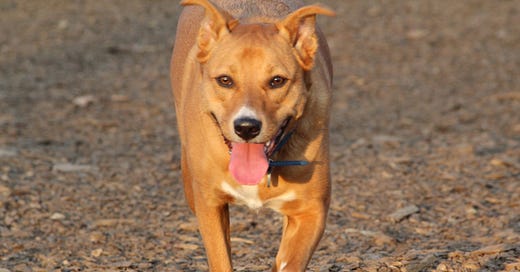



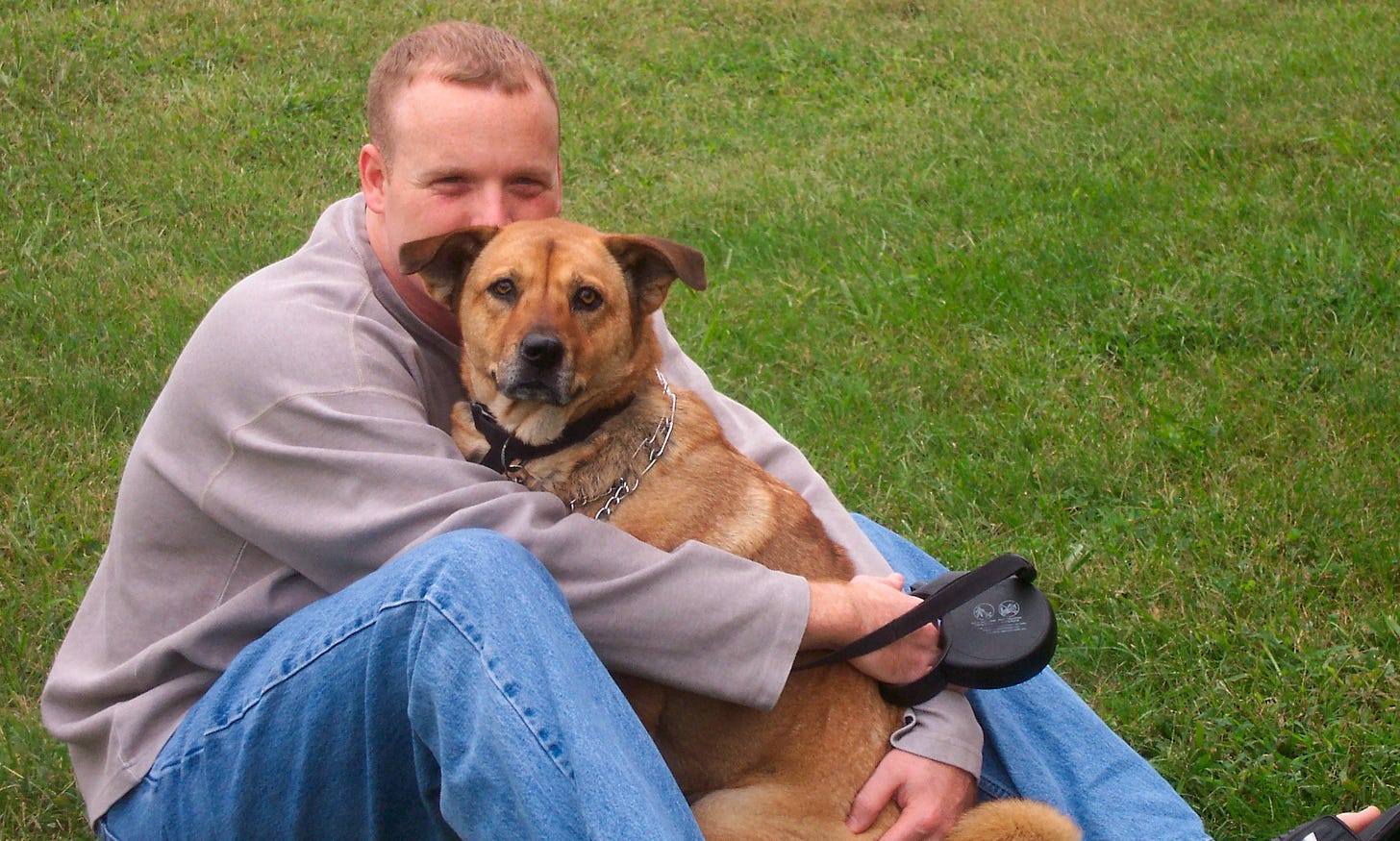

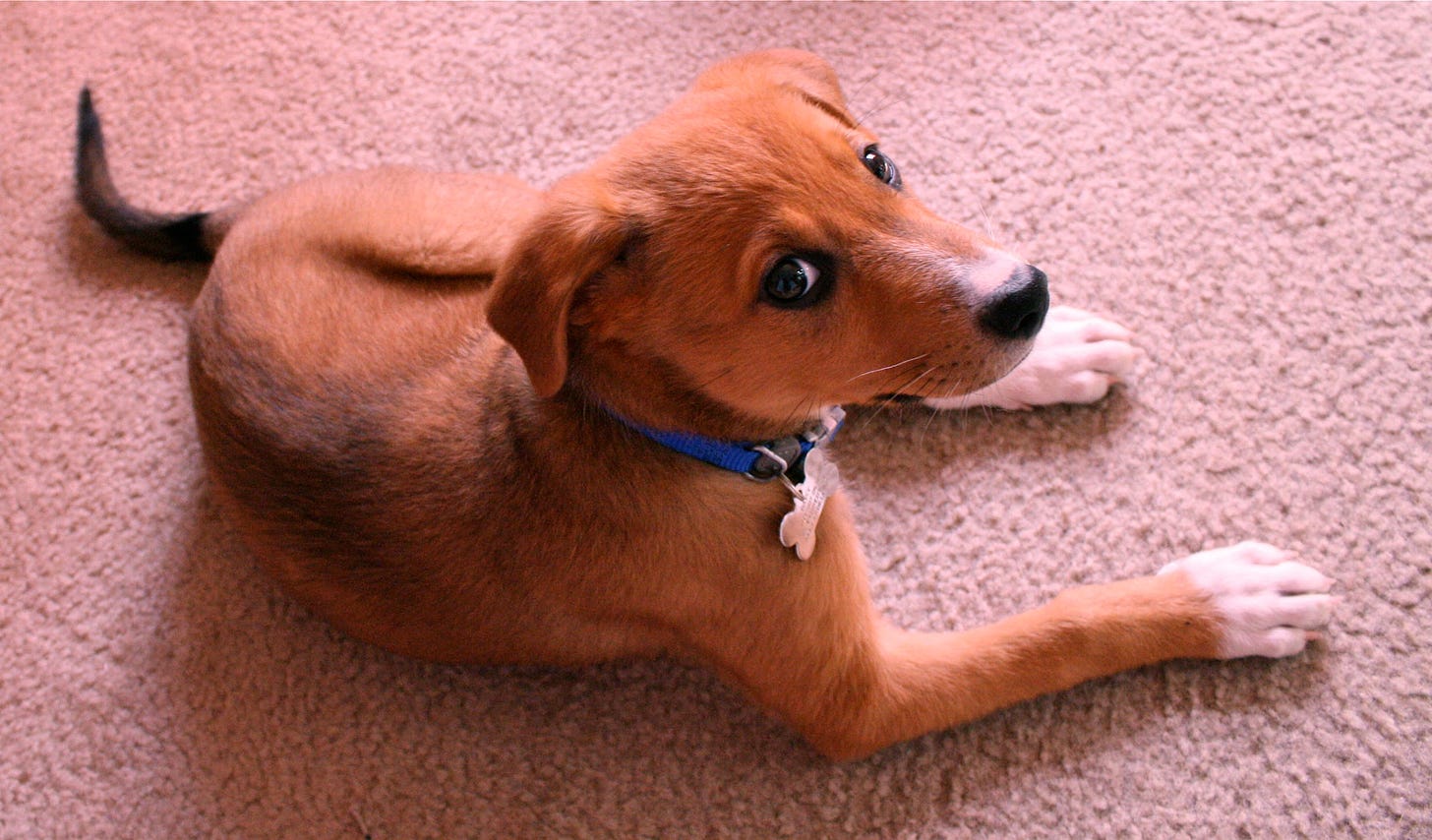



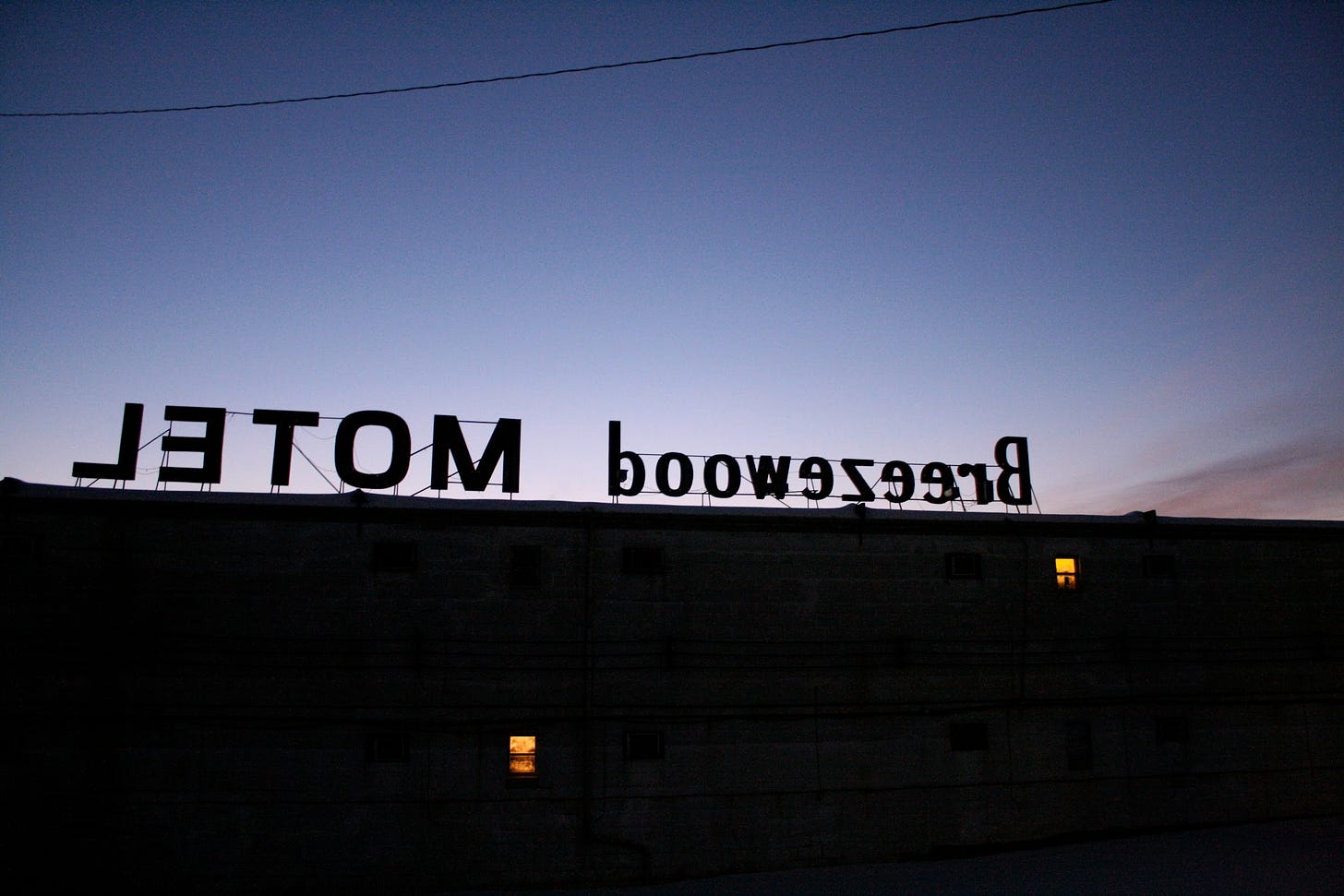





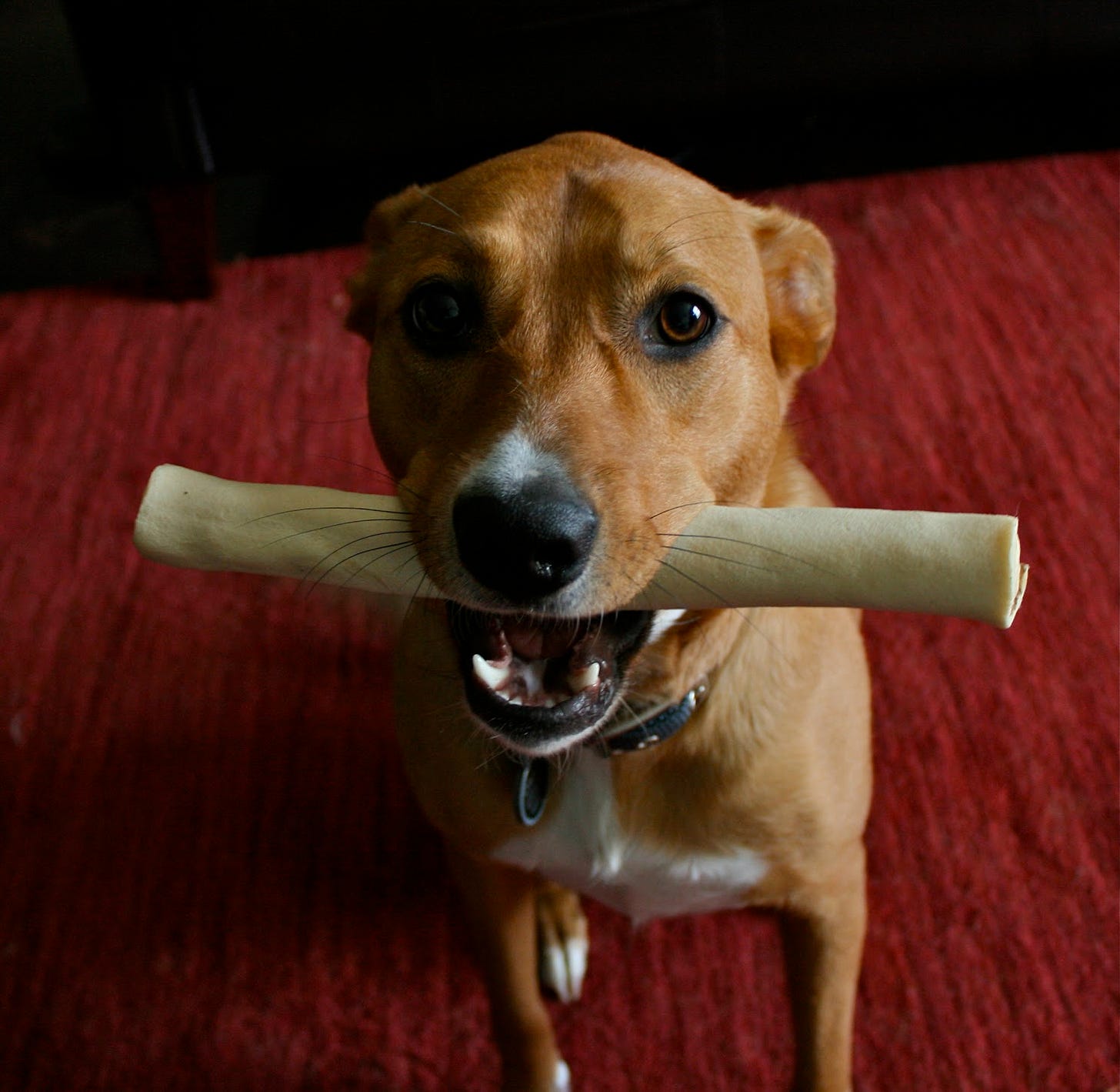
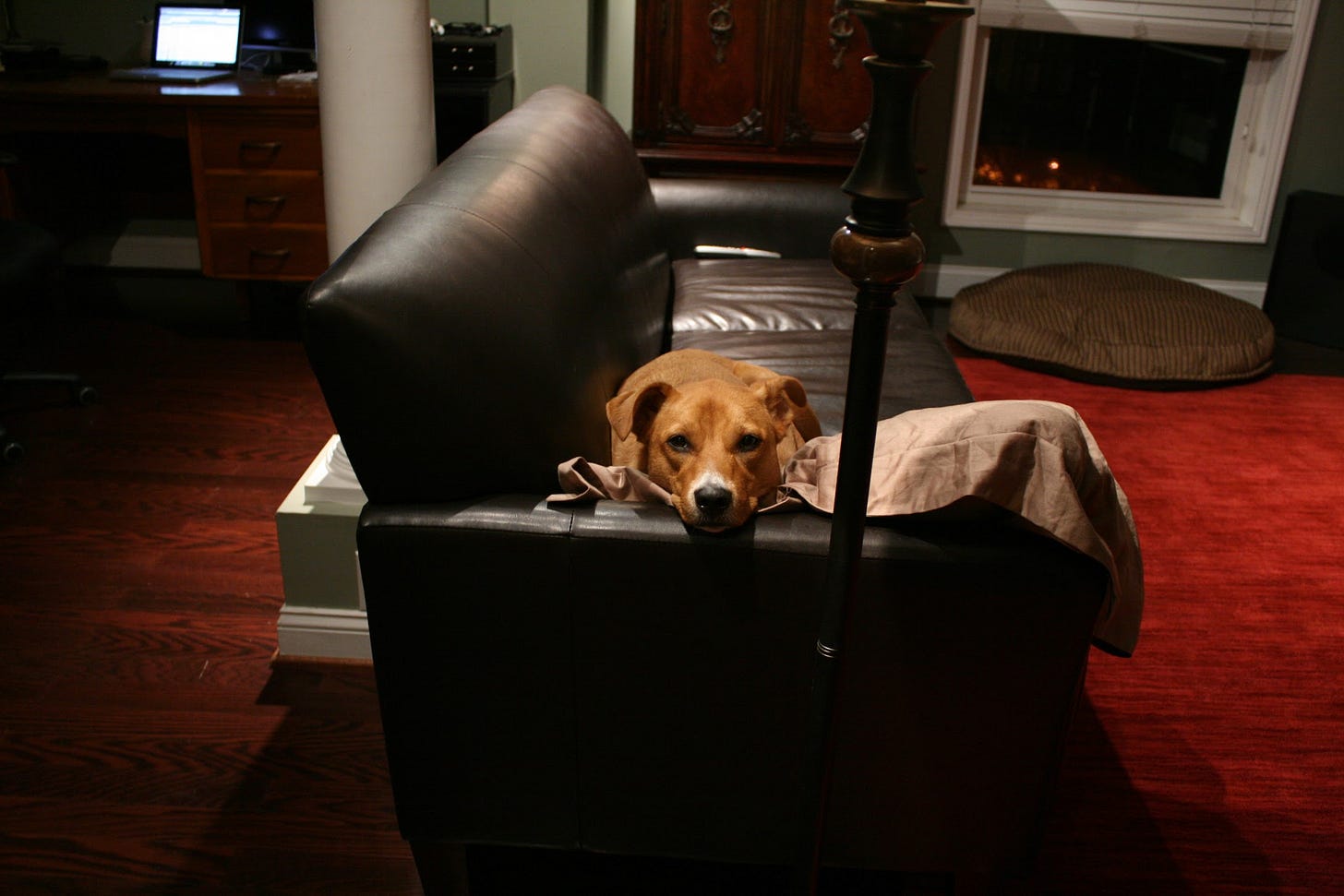
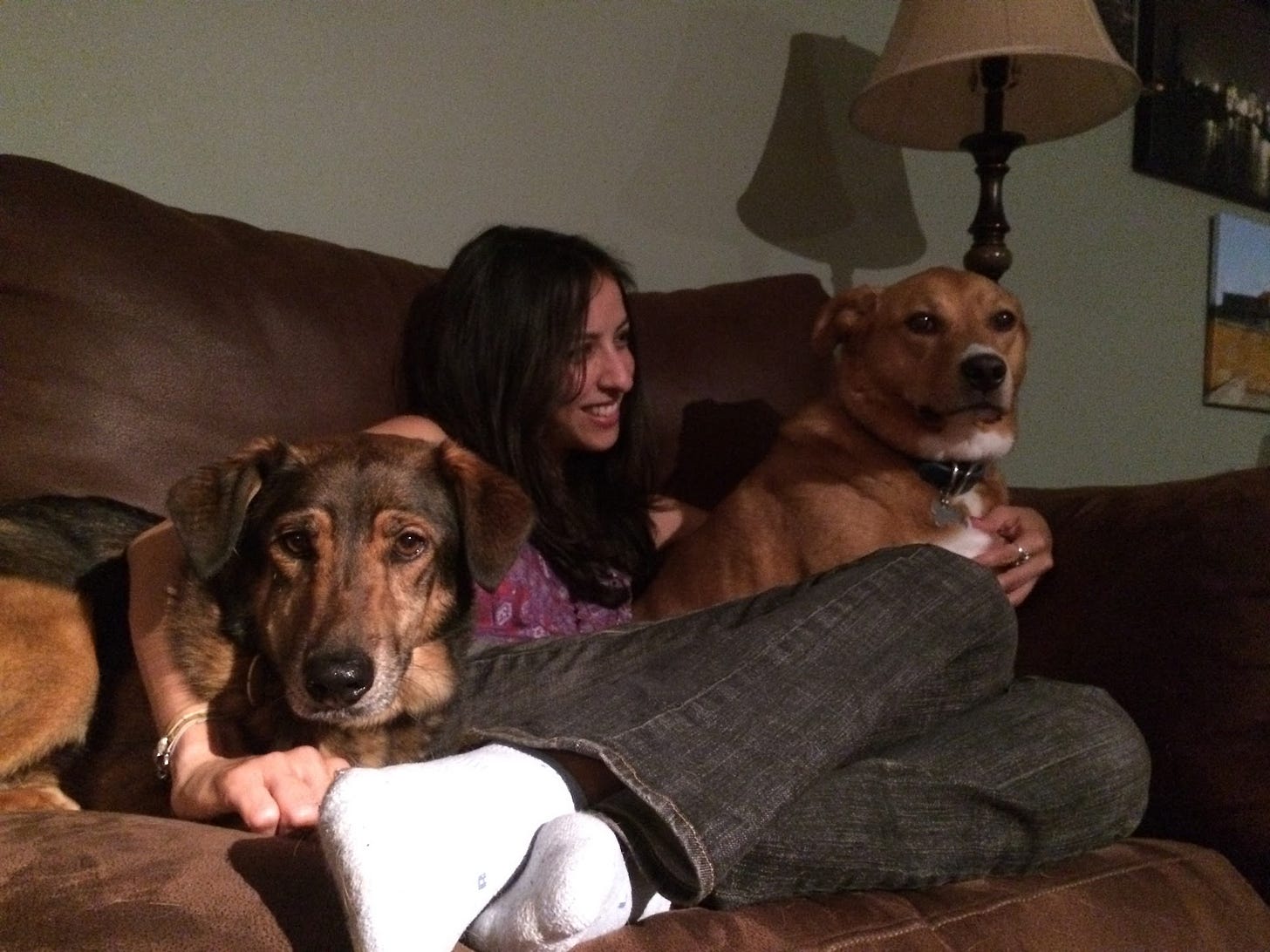

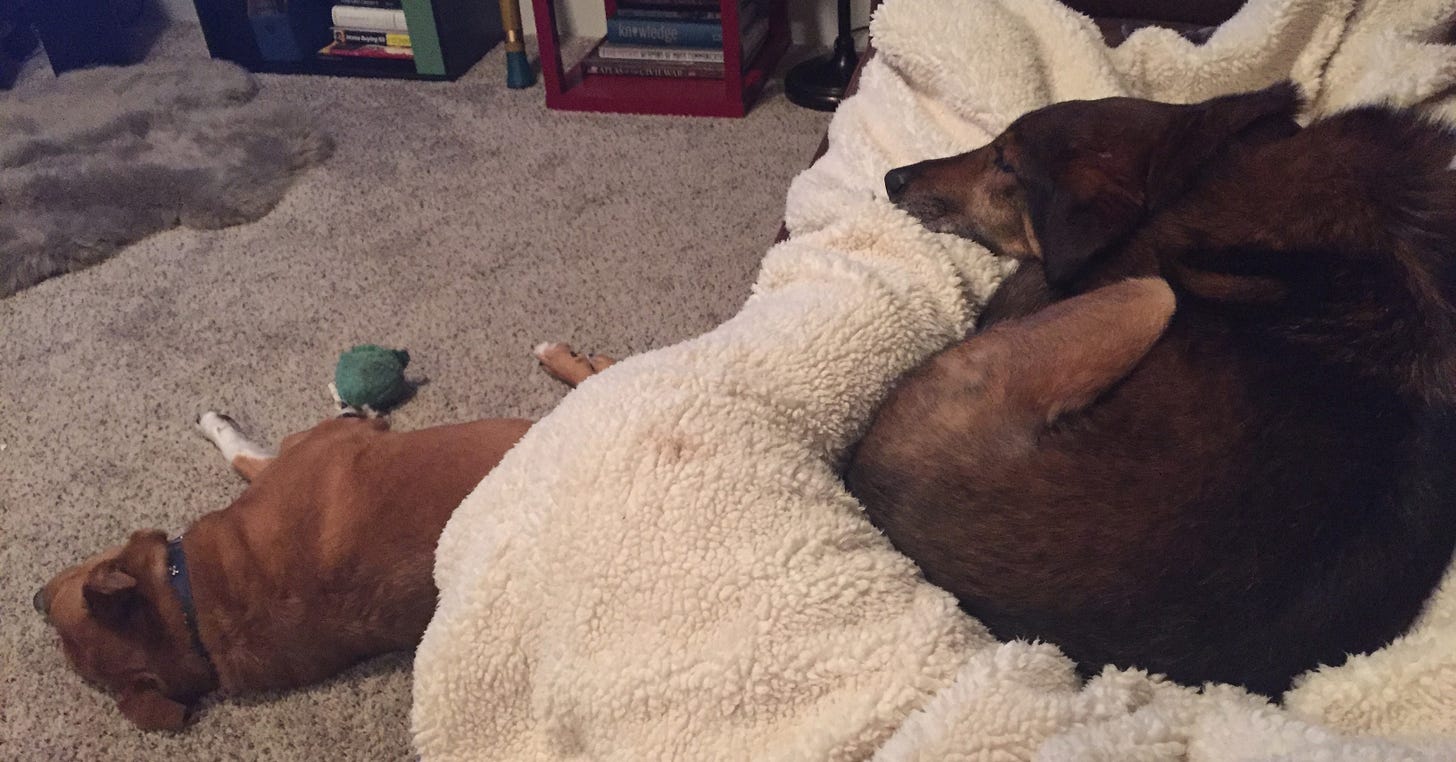
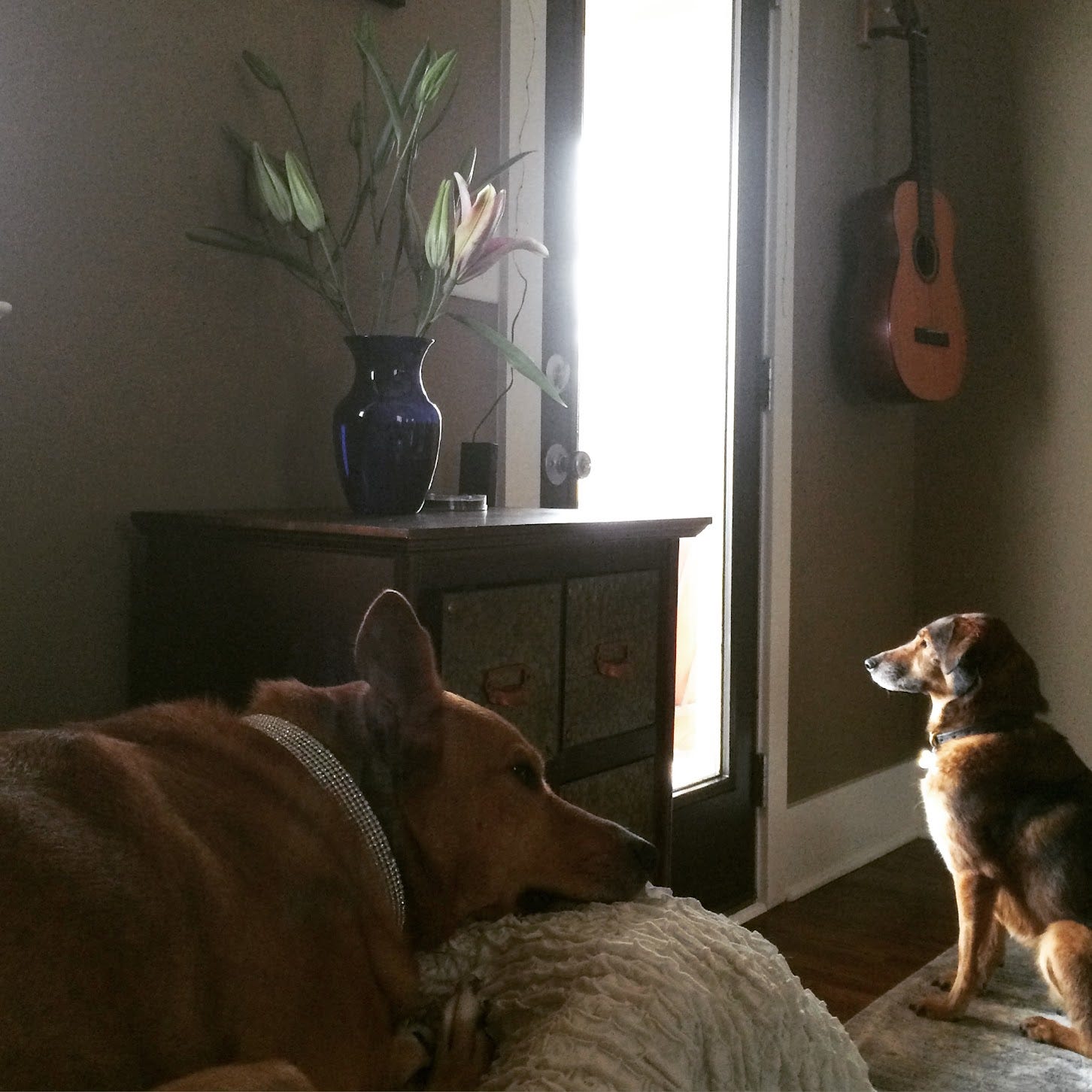







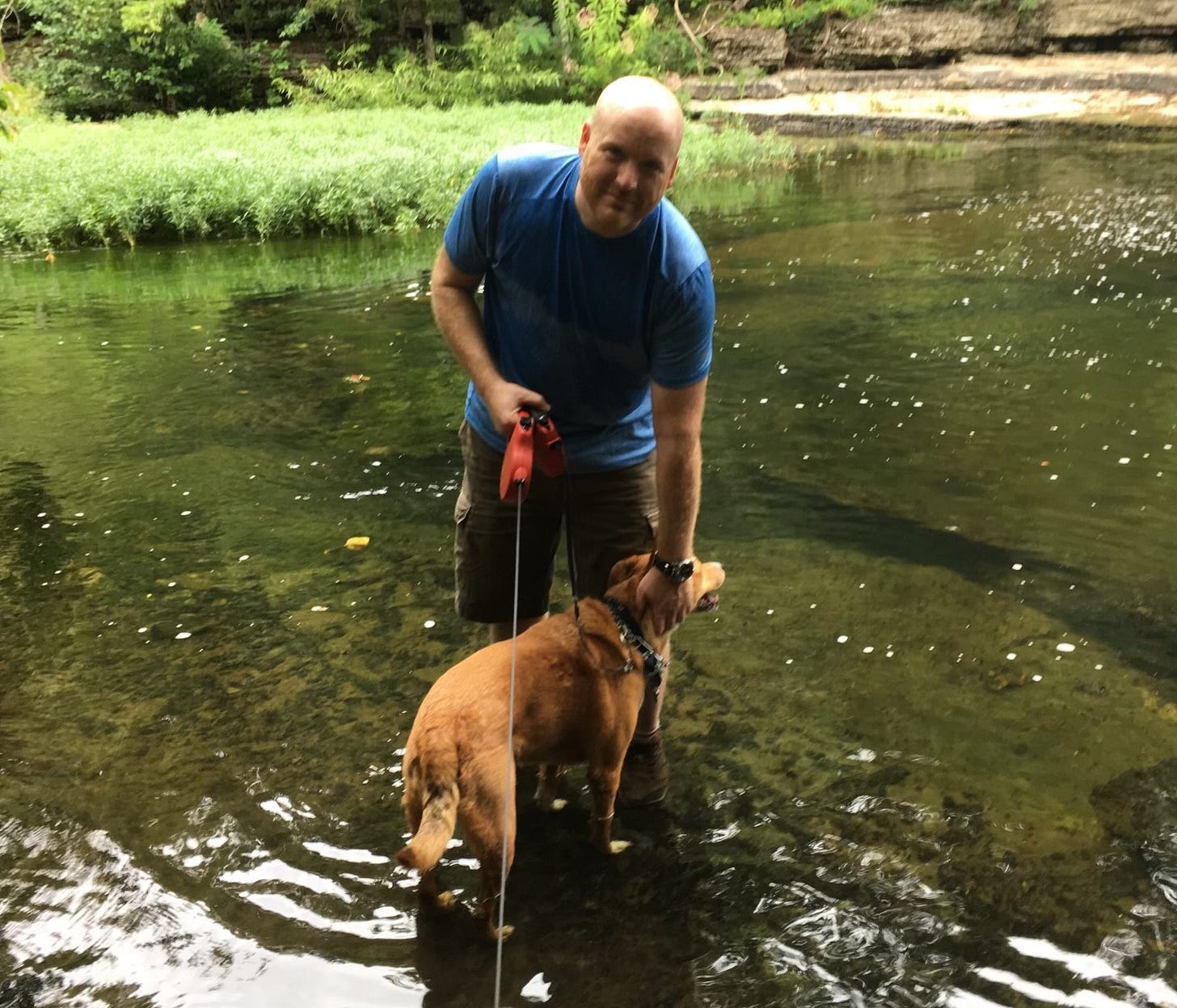

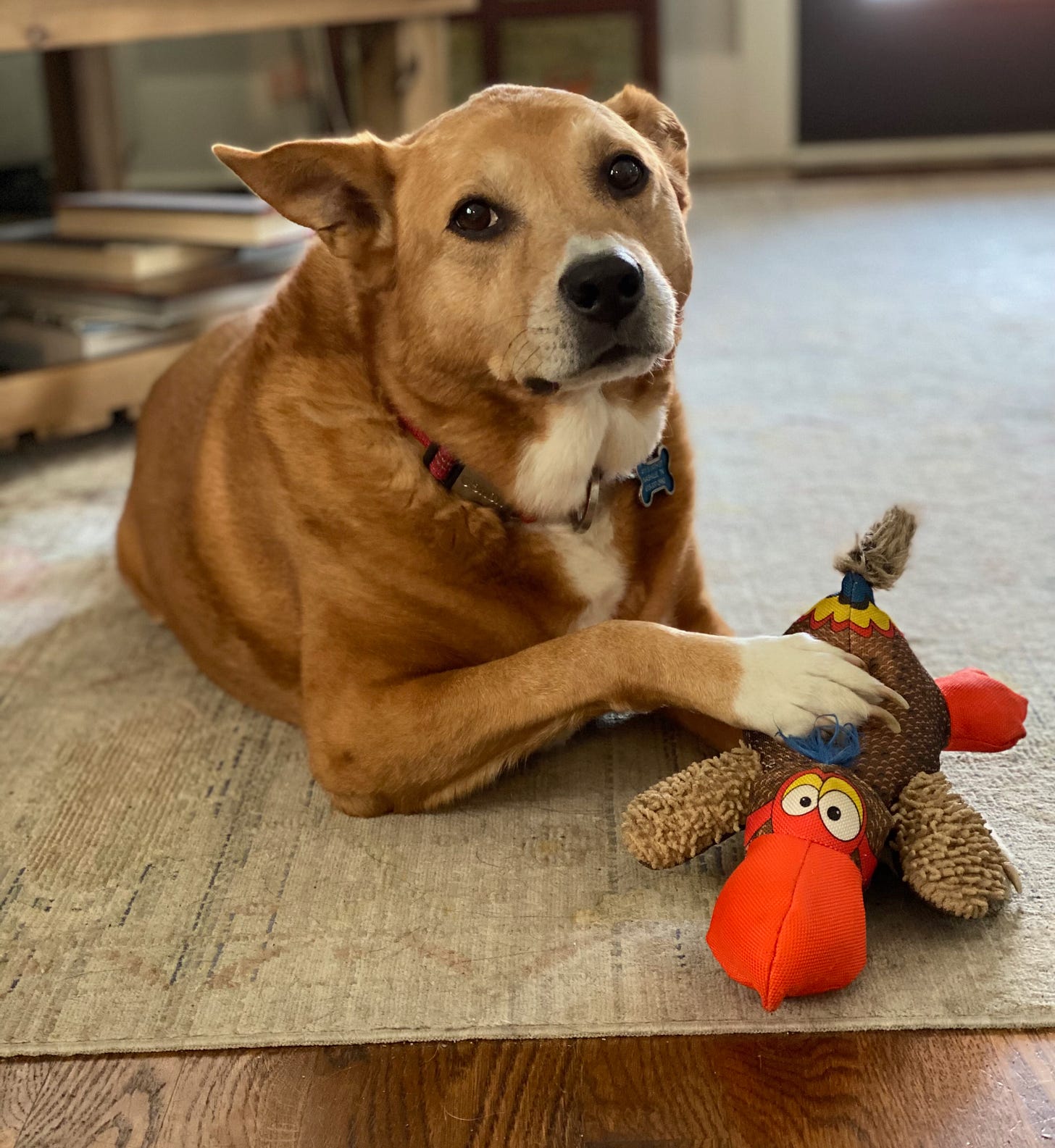





I'm typing through tears at this beautiful tribute, and I'm always mystified by those who don't realize that our four-legged housemates are full-fledged members of the family. Thank you.
For those of us who have pets throughout our lives, phases of our lives becomes defined by our pets' lives, just like they do relationships. Daisy's "You dumbass, marry this awesome woman" story reminds me of my wife's cocker spaniel, who basically fell in love with me. Right after I moved in, every morning that I'd leave for work, he'd howl as if I was never coming home, and wouldn't stop until my wife got up and actually touched him to comfort him. He kept it up for a month.
We've been together 25 years this Novermber.
May Daisy's memory be a blessing.